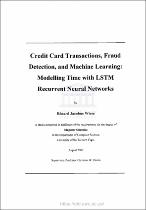| dc.description.abstract | In recent years, topics such as fraud detection and fraud prevention have received a lot of attention on the research front, in particular from plastic card issuers. The reason for this increase in research activity can be attributed to the huge annual financial losses incurred by card issuers due to fraudulent use of their card products. A successful strategy for dealing with fraud can quite literally mean millions of dollars in savings per year on operational costs. Artificial neural networks have come to the front as an at least partially successful method for fraud detection. The success of neural networks in this field is, however, limited by their underlying design - a feedforward neural network is simply a static mapping of input vectors to output vectors, and as such is incapable of adapting to changing shopping profiles of legitimate card holders. Thus, fraud detection systems in use today are plagued by misclassifications and their usefulness is hampered by high false positive rates. We address this problem by proposing the use of a dynamic machine learning method in an attempt to model the time series inherent in sequences of same card transactions. We believe that, instead of looking at individual transactions; it makes more sense to look at sequences of transactions as a whole; a technique that can model time in this context will be more robust to minor shifts in legitimate shopping behaviour. In order to form a clear basis for comparison, we did some investigative research on feature selection, pre-processing, and on the selection of performance measures; the latter will facilitate comparison of results obtained by applying machine learning
methods to the biased data sets largely associated with fraud detection. We ran experiments on real world credit card transactional data using three machine learning techniques: a conventional feedforward neural network (FFNN), and two innovative methods, the support vector machine (SVM) and the long short-term memory recurrent neural network (LSTM). | en_US |

